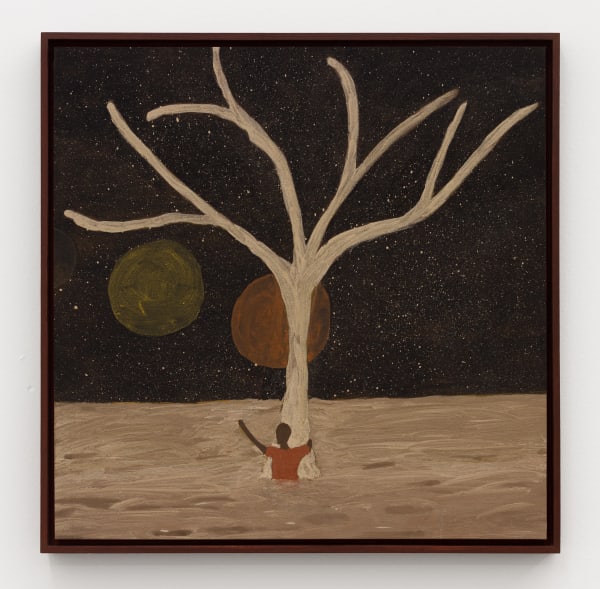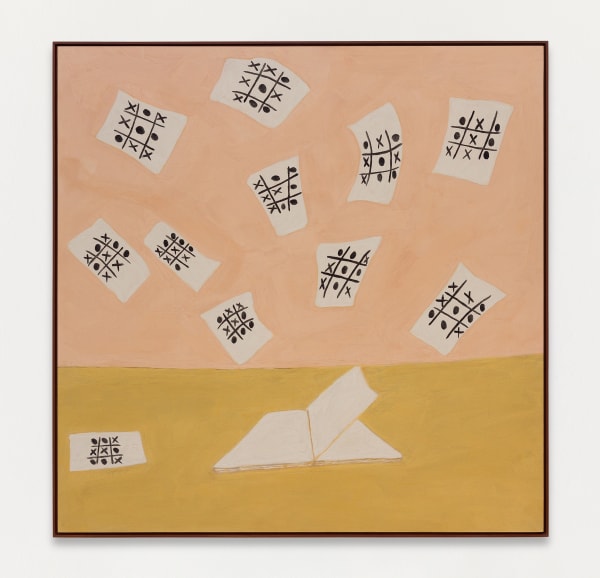Matutar Marcos Siqueira
Mendes Wood DM New York
31 Jul - 31 Aug 2024
Matutar: to ponder, to reflect, to consider, to express care
The inspiration for this text dates back to a year ago when I had the opportunity to spend a few days with Marcos Siqueira in Serra do Cipó, a national park in the state of Minas Gerais, Brazil. On that occasion, he and I set out one afternoon to walk through the Serra. Perhaps those reading this text now do not know how impactful this part of the State of Minas Gerais is. In its presence, one is constantly faced with its vast scale. The mountains, the vegetation, and the entire environment calls for perspectives that capture the monumental.
Marcos is one of the greatest connoisseurs of this region and its nature. From a very young age, he has lived many days and years in those mountains in the most diverse of ways: As a boy who, from an early age, worked the land with his family and as a man who acts as a fire brigade member, putting out fires that take over the Serra periodically during the year, mostly due to human actions.
Well, it was with this Marcos Siqueira that I encountered something unexpected on that outing. As we walked, he called me to step away from the immensity of the setting and turn my gaze to its intricate details: A plant that closes at the touch of a hand, another plush-textured one that he calls “rabbit’s ear,” and to the different qualities of soils we encountered. Details that are only perceived when one’s gaze extends and lingers on the tiny forms of life that may not reveal themselves unless you possess a special type of attention.
I have evoked this experience at the start of this text because, back in Siqueira’s home studio, I adopted a new way of seeing his paintings. There, where I became familiar with Marcos Siqueira’s pace and tempo, I was able to get to know his pigments, the wood that supports his work, and his process, which is nothing less than an act of delicacy, a search for the world’s minute intricacies.
The ochre chromaticism of Marcos Siqueira’s paintings emerges from a variety of soils found in the Serra do Cipó. Mixing soil with water and acrylic glue, colors are carefully collected, sieved, and prepared. At a time when debates about nature and the Anthropocene are increasingly prominent in artistic discourse, it is impossible to overlook new meanings within Siqueira’s process.
His images, which arise from a dreamlike environment, are not only illustrations of landscapes, nor grand treatises on life in a world with submerging cities, rising temperatures, and fracturing glaciers. Instead, the artist’s works create alternative ways of thinking about our relationship to the natural world.
Siqueira’s figures often appear in states of solitude, alone before nature. These environments result when the artist casts his lingering gaze upon everyday landscapes. We are called by this introspection of his surroundings, his pondering of the world.
In Brazil, the expression matutar implies a withdrawal from the moment to dedicate extended time to contemplation and pondering. The word appears in phrases such as eu estou matutando (I am considering it) or deixa eu matutar antes de responder (let me consider before I answer). Matutar is to retreat from the dizzying immediacy of the world, to pause in time before proceeding with a decision.
This may be one of the first entry points into this body of work. Nothing in the exhibition refers to spontaneity or naïveté, perspectives that are often used to distance Black artists from less affluent strata of Brazilian society. Here, let us remember that this exhibition takes place in the United States, where terms such as primitive, naïve, popular, and spontaneous are familiar descriptors of Afro-Brazilian work in a purported search for some kind of “authenticity.”
The pondering of the world, which appears in these paintings, sets in motion a sophisticated thought not “about” nature but with nature. There is no naïveté in this process but rather knowledge about art and the world that is realized in the materiality of the works.
In the exhibition, we take note of Siqueira’s formal gestures within the paintings. In many cases, the artist creates pictorial space with bands of color that change the relationship between figure and ground. In others, organic forms and geometries are most present. When I asked the artist about these geometries, he replied, “Just pay attention to the fittings that are found in the landscapes. The colors emerge through the encounter of different types of soil-made pigments. Here, form and material are inseparable.”
In many of Siqueira’s works, we see the figure of what seems to be a boy occupying the canvas, sometimes balancing on a thin line, carrying a ball, or launching balloons into the sky. Among all that these representations may suggest, we must attend to the silence that surrounds the figure; the works do not lend themselves to a single glance. Just as when learning the details of an unfamiliar landscape, one must leave behind their sense of the whole image.
One connection strikes me while seeing these figures alone in their environments. In the relationship between art, nature, and human presence, it is impossible not to think of the paintings of Caspar David Friedrich, especially the most celebrated of them all, Wanderer above the Sea of Fog(1818). In it, the figure of a man stands with his back turned to the viewer, gazing through the fog across a mountain range that extends to the limits of the canvas. He is engulfed before a world he only observes, with nature as a place that envelops and challenges humans.
In the past, wild nature seemed to exist only to be dominated by rational knowledge. We see the results of this understanding every day. Now, two centuries later, we are faced with an urgency to create another way of relating with the world.
If art is to take part in this, the poetics of Marcos Siqueira must be considered along the way.
– Igor Simões
Siqueira’s works have been featured in the solo exhibition Horizonte, Galeria Periscópio/Mitre Galeria, Belo Horizonte, Brazil (2022). He has participated in the following group exhibitions: Six Artists; Mendes Wood DM, New York, NY, USA (2023); DOS BRASIS – Arte e pensamento negro, SESC Belenzinho, São Paulo, Brazil (2023); maa, Mitre Galeria, Belo Horizonte, Brazil (2023); Frieze New York, New York, NY, USA (2023); Extrañar: verbo transitivo direto, Galeria Periscópio/Mitre Galeria, Belo Horizonte, Brazil (2022); and Corpocontinente, Galeria Periscópio/Mitre Galeria, Belo Horizonte, Brazil (2022).
-
 Marcos Siqueira, Untitled, 2024
Marcos Siqueira, Untitled, 2024 -
 Marcos Siqueira, Untitled, 2024
Marcos Siqueira, Untitled, 2024 -
 Marcos Siqueira, Untitled, 2023
Marcos Siqueira, Untitled, 2023 -
 Marcos Siqueira, Untitled, 2023
Marcos Siqueira, Untitled, 2023 -
 Marcos Siqueira, Untitled, 2024
Marcos Siqueira, Untitled, 2024 -
 Marcos Siqueira, Untitled, 2024
Marcos Siqueira, Untitled, 2024 -
 Marcos Siqueira, Untitled, 2024
Marcos Siqueira, Untitled, 2024 -
 Marcos Siqueira, Untitled, 2024
Marcos Siqueira, Untitled, 2024 -
 Marcos Siqueira, Untitled, 2024
Marcos Siqueira, Untitled, 2024 -
 Marcos Siqueira, Untitled, 2024
Marcos Siqueira, Untitled, 2024 -
 Marcos Siqueira, Untitled, 2024
Marcos Siqueira, Untitled, 2024 -
 Marcos Siqueira, Untitled, 2023
Marcos Siqueira, Untitled, 2023 -
 Marcos Siqueira, Untitled, 2024
Marcos Siqueira, Untitled, 2024 -
 Marcos Siqueira, Untitled, 2024
Marcos Siqueira, Untitled, 2024 -
 Marcos Siqueira, Untitled, 2024
Marcos Siqueira, Untitled, 2024 -
 Marcos Siqueira, Untitled, 2024
Marcos Siqueira, Untitled, 2024 -
 Marcos Siqueira, Untitled, 2024
Marcos Siqueira, Untitled, 2024 -
 Marcos Siqueira, Untitled, 2023
Marcos Siqueira, Untitled, 2023 -
 Marcos Siqueira, Untitled, 2024
Marcos Siqueira, Untitled, 2024 -
 Marcos Siqueira, Untitled, 2024
Marcos Siqueira, Untitled, 2024 -
 Marcos Siqueira, Untitled, 2023
Marcos Siqueira, Untitled, 2023 -
 Marcos Siqueira, Untitled, 2024
Marcos Siqueira, Untitled, 2024 -
 Marcos Siqueira, Untitled, 2024
Marcos Siqueira, Untitled, 2024 -
 Marcos Siqueira, Untitled, 2024
Marcos Siqueira, Untitled, 2024

























